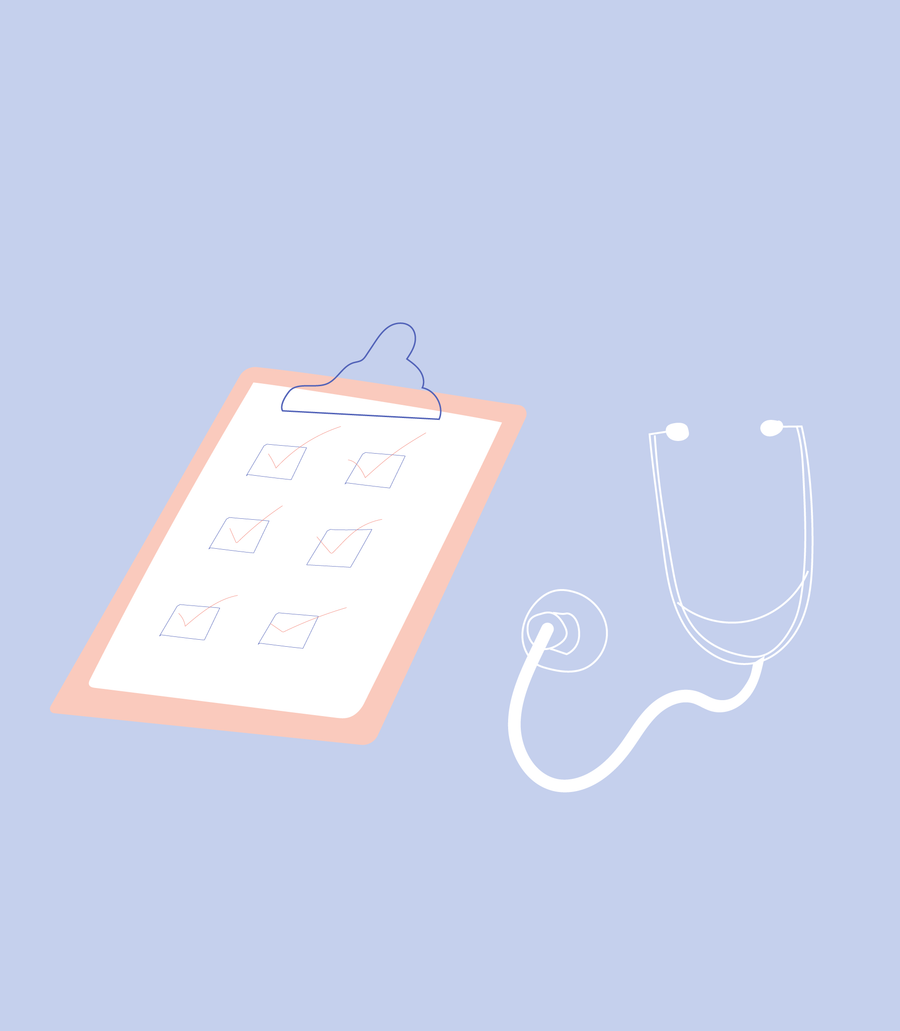The Preconception Checklist (Start Here!)

By Leslie Schrock, author of Bumpin’
You’ve heard of the first, second, and third trimesters of pregnancy, and maybe even the fourth. But trimester zero, aka the months leading up to conception, is actually the ideal period for you and your partner to get a jump start on what’s to come, as your life and relationship will change in obvious and non-obvious ways. Here is the ultimate guide for that trying-to-conceive (TTC) period:
💊 Revamp your lifestyles and medications
If you’re preparing your body for pregnancy, so too should your partner. Though the blame is usually directed at egg quality first, at least 40% of fertility issues are related to sperm. This means lifestyle changes, especially eliminating those behaviors and substances that are known to affect sperm or eggs. Now is also the time for both of you to stop using recreational drugs (including all forms of cannabis–even CBD), smoking or vaping, and reducing (or stopping) your alcohol and caffeine consumption.
Another stop on the journey is a preconception checkup. While it can be tempting to downplay questionable behavior with your physician, now is not the time for half-truths. For example, studies show that women commonly conceal how much alcohol they consume. If your practitioner is given incomplete or slightly fudged information, they can’t provide the best care. An important discussion topic for your appointment: some prescription drugs can impact sperm quality and quantity or are not appropriate during pregnancy. Ideally, medication changes should happen a few months before you start trying to conceive so your body can adjust.
📈Create a baby budget
Raising a child from birth to age seventeen costs around $233,610 for middle-income families today. Birth itself costs over an average of $10,000, and that is for an uncomplicated vaginal delivery. C-sections cost closer to $30,000. Full-time daycare is roughly $10,000 per year and a full-time nanny is about $30,000. If you live in a coastal city, these costs are much higher.
In other words, having a kid is not cheap, and these high costs come as a complete surprise to three out of every four parents. So the earlier you talk about and plan for this reality, the less likely you are to fight or feel unprepared for it later.
To start your baby budget, look at your current finances, available savings, and monthly burn rate. The two major pregnancy line items not wholly under your control are medical expenses and childcare, so begin researching and planning those costs before diving into the fun stuff like outfitting a nursery. This means talking to friends with kids in your area, talking about your plans for the postpartum period and return to work, and yes, looking into your insurance.
Money-saving pro tip: when you chat with friends, see if they have any items–maternity clothes or baby stuff–to borrow. After all, the baby won’t know the difference, and you’ll only be in maternity clothes (which you will hate by the end!) for a few months.
👩💼 Research your insurance plan (or get one!)
I know, this isn’t the fun stuff. But reviewing your coverage before you actually get pregnant allows you to find out whether your desired birth spot, practitioners, and pre and post services (if you know who those are) are included. Hard costs like deductibles, copays, and out-of-pocket maxes will also help you build the budget mentioned above, and doing this in advance means you will be able to change your policy if needed during an open enrollment period. Though it seems counterintuitive, birth, not pregnancy, is a qualifying life event that allows you to change on-demand.
So what is generally covered by insurance?
- Pre- and postnatal doctor’s appointments, labs, medications, and treatments or screenings for conditions like diabetes
- Inpatient experiences including birth, hospitalizations, and assorted hospital fees
- Breast pump and lactation counseling
- Newborn-baby care (shots and tests in the hospital, vaccines, well-baby visits)
Another benefit of understanding your insurance is that you may discover cool services that are partially or even fully covered. Depending on your plan, these can include acupuncture, physical therapy, a doula, massage, or 24/7 video access to a range of health professionals.
To optimize your healthcare benefits, it's essential to explore the advantages of Health Savings Accounts (HSAs) and Flexible Spending Accounts (FSAs). HSAs provide a pre-tax savings option for medical expenses, encompassing pregnancy-related expenses. Meanwhile, FSAs, typically offered through employers, offer pre-tax funds to offset medical costs. These versatile accounts can cover expenses like HSA and FSA pregnancy tests and supplements. For an in-depth understanding of utilizing HSAs and FSAs for pregnancy-related expenses, delve into our comprehensive guide on HSA and FSA Coverage of Fertility and Pregnancy Products.
🕘 Get to know your cycle
Hormonal birth control works (for the most part) by stopping ovulation; no ovulation, no pregnancy. For long-term birth-control users, stopping can be a BIG transition, and you can expect some hormonal and mood changes. The biggest change, however, is that with many formulations, you can get pregnant the very next cycle. The rhythm and pullout methods are not reliable, so use backup birth control if that is not your goal.
Some periods come right back the first month. Others take longer. Once your period does make an appearance, it’s best to complete at least one full cycle before trying to conceive, to more accurately pinpoint your ovulation window. It also helps with more exact dating if you get pregnant, as your due date is calculated based on the start of your last menstrual period (LMP). And though we are all conditioned to think they are normal, PMS symptoms like bloating, cramps, and acne are typically signs of hormonal imbalances and can say a lot about the state of your fertility. If yours are extreme, talk to your favorite practitioner to debug.
Here are the basics of a normal, healthy menstrual cycle:
- Full cycle length: twenty-five to thirty-five days (a consistent duration month to month is more important than length)
- Bleeding duration: four to seven days
- Color: bright red (think cranberry juice) with no clots
- Volume: If you are filling up a tampon, pad, or cup in under four hours, it’s likely too much and you should chat with your OBGYN
To begin tracking your cycle, start with Ovulation Tests, which can be found in our TTC kit, along with a variety of other pregnancy essentials.
📅 Start taking prenatal vitamins earlier than you think
The ideal time to start taking a prenatal is actually three months before you try to conceive so levels can build up in your system–not once you are actually pregnant. You’ll also continue to take them post-pregnancy if you are breastfeeding. Powered by folic acid, they are proven to reduce neural tube and heart defects, preterm birth, low birth weights, and even Autism.
Consider starting your prenatal journey with his and her fertility vitamins to ensure you and your partner are both supported with the essential nutrients needed for a healthy pregnancy and beyond.
When you go shopping, here are the top ingredients to seek out:
- Folic acid (5-MTHF is a great choice if available)
- Iron
- Calcium
- Vitamin D
- Iodine
- Choline
- Omega-3 fatty acids (DHA and EPA)
The iron in prenatal vitamins can cause stomach issues and nausea, so take them at night before you go to bed, with a snack, or look for food-based versions that are easier to digest.
👨👩👧 Share your #ParentingGoals
A big mental hurdle for most first-time parents is deciding who they are and how they want to show up in the world as parents. This identity is tied to so many things–your age, your professional experience, how you perceive gender roles and responsibilities, your own childhood, and your financial resources, just to name a few.
Start by asking yourself why you want to have a child, and if you have a specific idea of what your future family will look like. There is no right answer, just what feels right to you. Then consider what kind of parent you’d like to be. Share with your significant other and see how their vision overlaps with yours. Even if you’ve talked about it before, you might find there are areas where you diverge now that it’s all becoming real.
Practicing co-parenting and communication now will pay major dividends when you have a tiny screaming infant around. And as time goes on, your conversations and opinions will evolve, as will your individual and shared identities. The critical thing is to keep talking and stay open.
Check out Parent Plans, a book of guided exercises for you and your partner.
☀️ Be patient and keep things light
Conception can quickly become stressful and obsessive, especially timing sex and calculating fertile windows. Add hormonal changes (especially if you just quit taking birth control) or worry when things don’t happen immediately, and any joy in the creation of new life can vanish.
Your mission: Be patient, and find ways to defuse the anxiety and keep things fun. Schedule a date night over your favorite take out at home. Try to keep each other distracted, especially if getting pregnant takes a bit of time. Keep the lines of communication open. And even if you’re not the type to talk about your feelings, be honest about how you are dealing.
Shop Products From This Article
Backed by science, trusted by mothers
We’re glad you’re here—join thousands of happy customers on the journey to parenthood and beyond.
Shop Now























